-
You cannot add "Rhaphidophora decursiva 'Dragon Tail' 4"" to the cart because the product is out of stock.
Showing 49–64 of 69 results
-


$9.99
Pilea peperomioides Care
Light: Provide bright, indirect sunlight for your Pilea peperomioides. It prefers moderate to bright indirect light.
Watering: Allow the top inch or so of the soil to dry out between waterings. Pilea peperomioides prefers slightly moist soil but can be sensitive to overwatering.
Humidity: Pilea peperomioides can tolerate average indoor humidity levels.
Temperature: Keep the plant in temperatures between 65-75°F (18-24°C).
Soil: Use a well-draining potting mix, such as a mix designed for succulents or cacti.
Fertilization: Feed your Pilea peperomioides with a balanced, diluted, water-soluble fertilizer during the growing season (spring and summer). Apply the fertilizer every 4-6 weeks to provide essential nutrients.
-


$7.99
Pothos ‘Golden’ Care
Light: Pothos ‘Golden’ thrives in medium to bright indirect light. It can tolerate lower light conditions, but its variegation will be more pronounced and vibrant in brighter light.
Watering: Allow the top inch or two of the soil to dry out before watering. Pothos prefers slightly moist soil but is quite forgiving if you occasionally let the soil dry out more.
Humidity: Pothos ‘Golden’ is adaptable to average indoor humidity levels.
Temperature: Keep the plant in temperatures between 60-85°F (15-29°C).
Soil: Use a well-draining potting mix. A mix designed for indoor plants or a mixture of potting soil, perlite, and orchid bark can work well.
Fertilization: Feed your Pothos ‘Golden’ with a balanced, diluted, water-soluble fertilizer every 4-6 weeks during the growing season (spring and summer).
-
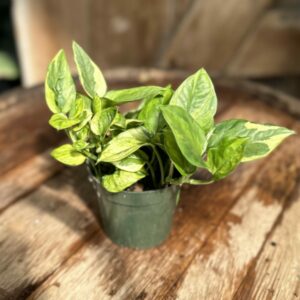
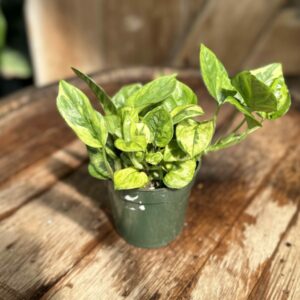
$19.99
Pothos ‘Lizard Queen’ Care
Light: Provide bright, indirect sunlight for your Pothos ‘Lizard Queen.’ It can tolerate lower light conditions, but for the best coloration and growth, place it in medium to bright indirect light.
Watering: Allow the top inch or so of the soil to dry out before watering. Pothos ‘Lizard Queen’ prefers slightly moist soil but is relatively forgiving if you occasionally let the soil dry out more.
Humidity: Pothos ‘Lizard Queen’ is adaptable to average indoor humidity levels.
Temperature: Keep the plant in temperatures between 60-85°F (15-29°C).
Soil: Use a well-draining potting mix. A mix designed for indoor plants or a mixture of potting soil, perlite, and orchid bark can work well.
Fertilization: Feed your Pothos ‘Lizard Queen’ with a balanced, diluted, water-soluble fertilizer every 4-6 weeks during the growing season (spring and summer).
-


$19.99
Pothos ‘Manjula’ Care
Light: Provide bright, indirect sunlight for your Pothos ‘Manjula.’ It thrives in medium to bright indirect light.
Watering: Allow the top inch or so of the soil to dry out before watering. Pothos ‘Manjula’ prefers slightly moist soil but is forgiving if you occasionally let the soil dry out more.
Humidity: Pothos ‘Manjula’ is adaptable to average indoor humidity levels.
Temperature: Keep the plant in temperatures between 60-85°F (15-29°C).
Soil: Use a well-draining potting mix. A mix designed for indoor plants or a combination of potting soil, perlite, and orchid bark can work well.
Fertilization: Feed your Pothos ‘Manjula’ with a balanced, diluted, water-soluble fertilizer every 4-6 weeks during the growing season (spring and summer).
-

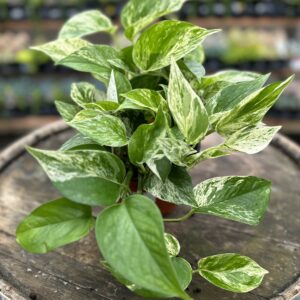
$24.99
Pothos ‘Marble Queen’ Care
Light: Provide bright, indirect sunlight for your Pothos ‘Marble Queen.’
Watering: Allow the top inch or so of the soil to dry out before watering. Pothos ‘Marble Queen’ prefers slightly moist soil but is relatively forgiving if you occasionally let the soil dry out more.
Humidity: Pothos ‘Marble Queen’ is adaptable to average indoor humidity levels.
Temperature: Keep the plant in temperatures between 60-85°F (15-29°C).
Soil: Use a well-draining potting mix. A mix designed for indoor plants or a combination of potting soil, perlite, and orchid bark can work well.
Fertilization: Feed your Pothos ‘Marble Queen’ with a balanced, diluted, water-soluble fertilizer every 4-6 weeks during the growing season (spring and summer).
-


$24.99
Pothos ‘N’Joy’ Care
Light: Provide bright, indirect light for your Pothos ‘N’joy.’ It thrives in medium to bright, indirect sunlight. It can tolerate low light conditions, but its variegation may become less pronounced. Avoid exposing it to direct sunlight, as this can scorch the leaves.
Temperature: Maintain a warm and consistent temperature. Pothos ‘N’joy’ prefers temperatures between 65°F to 80°F (18°C to 27°C). Protect it from cold drafts and sudden temperature fluctuations.
Pot and Soil: Plant your Pothos ‘N’joy’ in well-draining potting mix. A standard indoor plant mix with good drainage works well. Ensure the pot has drainage holes to prevent waterlogged soil.
Watering: Allow the soil to dry out slightly between waterings. Water sparingly but thoroughly, making sure the pot has drainage holes. Water when the top inch of soil feels dry. Pothos are relatively forgiving of underwatering but are sensitive to overwatering.
Humidity: Pothos ‘N’joy’ can tolerate average indoor humidity levels. However, they appreciate a bit of extra humidity. Misting the plant or using a humidity tray can help.
Fertilization: Feed your Pothos ‘N’joy’ sparingly. Use a balanced, water-soluble fertilizer diluted to half the recommended strength. Fertilize every 4-6 weeks during the growing season (spring and summer) and reduce or stop fertilization during the dormant period (fall and winter).
-


$24.99
Pothos ‘Neon’ Care
Light: Provide bright, indirect sunlight for your Pothos ‘Neon.’
Watering: Allow the top inch or so of the soil to dry out before watering. Pothos ‘Neon’ prefers slightly moist soil but is forgiving if you occasionally let the soil dry out more.
Humidity: Pothos ‘Neon’ is adaptable to average indoor humidity levels.
Temperature: Keep the plant in temperatures between 60-85°F (15-29°C).
Soil: Use a well-draining potting mix. A mix designed for indoor plants or a combination of potting soil, perlite, and orchid bark can work well.
Fertilization: Feed your Pothos ‘Neon’ with a balanced, diluted, water-soluble fertilizer every 4-6 weeks during the growing season (spring and summer).
-

$16.95
Sansevieria ‘Starfish Boncel’ (Green) Care
Light: Sansevieria ‘Starfish Boncel’ prefers bright, indirect sunlight.
Watering: Allow the top inch or two of the soil to dry out between waterings. Water sparingly, as Sansevieria is drought-tolerant.
Humidity: Sansevieria ‘Starfish Boncel’ is adaptable to normal indoor humidity levels..
Temperature: Keep the plant in temperatures between 60-80°F (15-27°C).
Soil: Use a well-draining cactus or succulent potting mix.
Fertilization: Sansevieria ‘Starfish Boncel’ doesn’t require frequent fertilization. You can feed it with a diluted, balanced, water-soluble fertilizer every 2-3 months during the growing season (spring and summer).
-

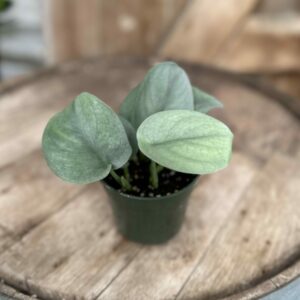
$29.99
Scindapsus pictus ‘Silver Hero’ Care
Light: Provide bright, indirect sunlight for your Scindapsus pictus ‘Silver Hero.’
Watering: Allow the top inch or so of the soil to dry out before watering.
Humidity: Scindapsus pictus ‘Silver Hero’ appreciates higher humidity levels.
Temperature: Keep the plant in temperatures between 60-85°F (15-29°C).
Soil: Use a well-draining potting mix. A mix designed for indoor plants or a combination of potting soil, perlite, and orchid bark can work well.
Fertilization: Feed your Scindapsus pictus ‘Silver Hero’ with a diluted, balanced, water-soluble fertilizer every 4-6 weeks during the growing season (spring and summer).
-
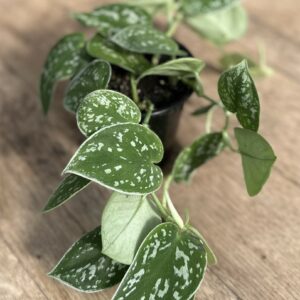

$9.99
Scindapsus pictus ‘Silver Satin’ Care
Light: Provide bright, indirect sunlight for your Scindapsus pictus ‘Silver Satin.’
Watering: Allow the top inch or so of the soil to dry out before watering.
Humidity: Scindapsus pictus ‘Silver Satin’ appreciates higher humidity levels.
Temperature: Keep the plant in temperatures between 60-85°F (15-29°C).
Soil: Use a well-draining potting mix. A mix designed for indoor plants or a combination of potting soil, perlite, and orchid bark can work well.
Fertilization: Feed your Scindapsus pictus ‘Silver Satin’ with a diluted, balanced, water-soluble fertilizer every 4-6 weeks during the growing season (spring and summer).
-
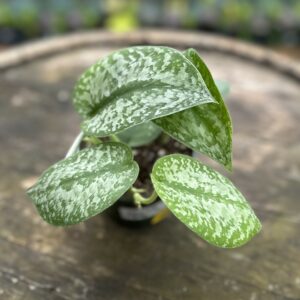
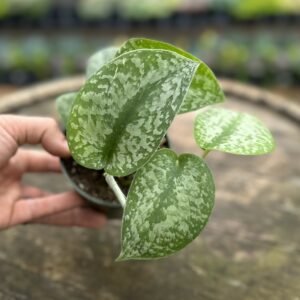
$14.99
Scindapsus pictus ‘Silver Splash’ Care
Light: Medium to bright, indirect light. Avoid direct sunlight.
Watering: Allow the top inch of soil to dry out between waterings. Water thoroughly; ensure excess drains to prevent root rot. Reduce watering in winter.
Humidity: Prefers higher humidity. Mist leaves occasionally or use a pebble tray.
Temperature: Maintain temperatures between 65-85°F (18-29°C). Avoid cold drafts.
Soil: Use well-draining, peat-based potting mix.
Fertilization: Feed with balanced liquid fertilizer (half strength) monthly during the growing season.
-
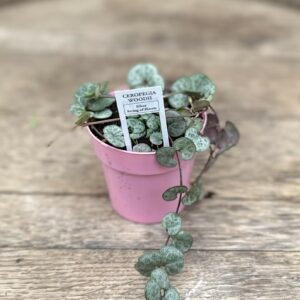
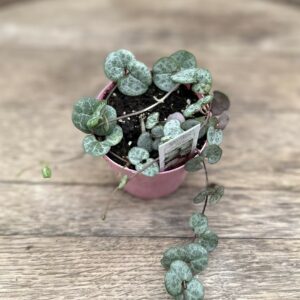
$9.99
String of Hearts ‘Silver’ Care
Light: Bright, indirect sunlight.
Watering: Allow the soil to dry out partially between waterings.
Soil: Use a well-draining succulent or cactus potting mix.
Temperature and Humidity: Prefers average room temperatures between 65°F to 80°F (18°C to 27°C).
Fertilizing: During the growing season, feed your String of Hearts with a balanced, diluted liquid fertilizer every 4-6 weeks.
-

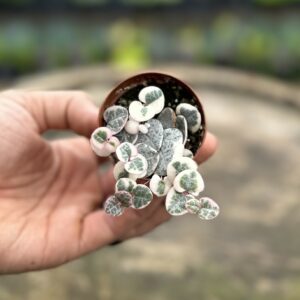
$5.99
String of Hearts (variegated) Care
Light: Bright, indirect sunlight.
Watering: Allow the soil to dry out partially between waterings.
Soil: Use a well-draining succulent or cactus potting mix.
Temperature and Humidity: Prefers average room temperatures between 65°F to 80°F (18°C to 27°C). Normal indoor humidity levels are typically sufficient.
Fertilizing: During the growing season, feed your String of Hearts with a balanced, diluted liquid fertilizer every 4-6 weeks.
-
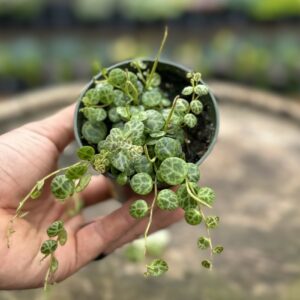

$9.99
String of Turtles Care
Light: Bright, indirect light.
Watering: Allow the top inch (2.5 cm) of soil to dry out before watering.
Soil: Use a well-draining potting mix formulated for succulents or cacti.
Temperature and Humidity: Keep your Peperomia prostrata in a temperature range of 65°F to 80°F (18°C to 27°C). Normal indoor humidity levels are usually suitable, but it appreciates a bit of extra humidity, especially during dry winter months.
Fertilizing: During the growing season (spring and summer), feed your Peperomia prostrata with a balanced, diluted liquid fertilizer every 4-6 weeks.
-


$29.99
Syngonium ‘Albo’ Care
Light: Provide bright, indirect sunlight for your Syngonium ‘Albo.’
Watering: Allow the top inch or so of the soil to dry out before watering.
Humidity: Syngonium ‘Albo’ appreciates higher humidity levels.
Temperature: Keep the plant in temperatures between 60-85°F (15-29°C).
Soil: Use a well-draining potting mix. A mix designed for indoor plants or a combination of potting soil, perlite, and orchid bark can work well.
Fertilization: Feed your Syngonium ‘Albo’ with a balanced, diluted, water-soluble fertilizer every 4-6 weeks during the growing season (spring and summer).
-
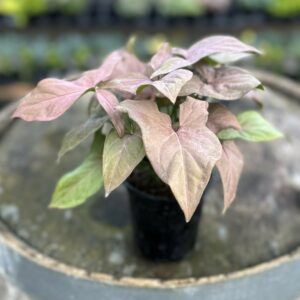
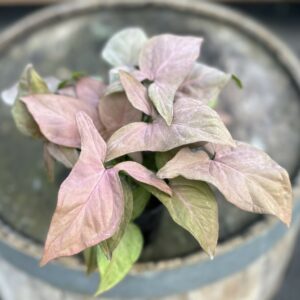
$11.99
Syngonium ‘Pink Splash’ Care
Light: Bright, indirect light; avoid direct sunlight.
Watering: Keep soil consistently moist but not waterlogged.
Humidity: Prefers higher humidity; mist occasionally.
Temperature: Maintain temperatures between 60-80°F (16-27°C).
Soil: Use well-draining, peat-based potting mix.
Fertilization: Feed monthly with balanced liquid fertilizer during the growing season.































